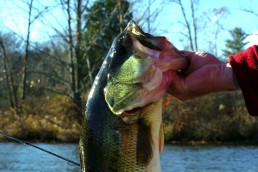How a Bass Sees Color
SHARE THIS POST
Longtime guide Malcolm Lane and I both believe that color is our least important consideration when choosing bass lures. This may seem controversial, but we don’t just base it on personal observations. Some solid science has greatly influenced our opinions.
In the first place, it probably is a mistake to judge the vision of the bass on our own because bass see everything a bit differently than us, and not just because they live in different environment. It’s because their eyes function much differently than ours.
For one, their eyes are placed on the sides of their heads, affording them “monocular vision,” which means they can see well on both sides of their heads simultaneously. Each eye has the ability to see over a 180-degree range, so their only “blind spot” is a narrow area directly behind them where their body obstructs their vision. We have “binocular vision,” which restricts our field of view to the front but allows us great depth-of-field perception.
Fish are nearsighted, so unless a lure makes noise, it needs to be cast closely to a bass to be detected. Fish also have limited binocular vision, similar to ours, and in a narrow band directly in front of them. Their binocular vision, however, is really just an overlapping of their monocular vision. So although they can see things at a little greater distance, the objects are blurred and depth perception is impaired, sort of like the way we see if we cross our eyes slightly. This is why you often see a bass make a little swoop to the side at the last second before they strike a lure they’ve been following from behind. This little sidestep at the last second allows them to see the bait the most clearly the instant before they take it. Short strikes or complete misses could mean they saw something distasteful upon closer inspection. Under their clearest vision and during a last-second swoop, a bass sometimes changes its mind like a batter checking his swing on a pitch he decides is not good to hit.
Are you enjoying this post?
You can be among the first to get the latest info on where to go, what to use and how to use it!
Scientists believe that bass receive about five times more light through their eyes than humans. This, of course, gives them better vision in deep, dark areas, but it doesn’t mean they can see five times better than a human. Simply put, they are five times more sensitive to light. They have a fixed lens, and their cornea is of uniform thickness. They don’t have eyelids or pupils to dilate and compensate, so they make up for this by seeking shade or moving deeper. The bass need this extra sensitivity because water absorbs light quickly. The deeper or more turbid the water, the less light there is to reflect off objects. Plus, when ripples break the surface, some of the light is refracted so the diffusion of light is rapid. Often, just a few feet or the shade of a fallen tree is enough.
The most confusing aspect of their sight is the fact they have two types of receptor cells in their retina. Their “cone” cells perceive color and are used mostly during the day; their “rod” cells see only in black and white and are used at night. These receptor cells reverse themselves every 24 hours, so bass are actually color blind about half the time. Consider that the next time you’re trying to pick out the perfect color.
Sometime before sunset, a bass’ internal senses trigger the advance of black and white vision in preparation for darkness. Completion of this process takes hours, so it’s believed they have a sort of “color fade” as the rod cells advance. Then, just before daylight, the cone cells begin to advance, causing a gradual recognition of colors. For most of the morning and for most of the evening, their ability to distinguish different hues of the color spectrum is limited. Ironically, that is usually when we do best with our lures of many colors.
We often think that the color of a lure was why a bass hit this or that model, when in fact most of the bass we catch are fooled during times when they can’t actually distinguish the difference between colors well. If what you’re using is catching them well during the middle of the day, color might be the key. Early and late in the day, however, they may be hitting that “latest and greatest” model not because of the fancy finish that caught your eye and emptied your pocket, but are doing so in spite of it, making presentation the important factor.
MWO
SHARE THIS POST
Did you enjoy this post?
You can be among the first to get the latest info on where to go, what to use and how to use it!
Ron Kruger
Ron Kruger has been communicating the outdoor experience for more than four decades. He has worked as a full-time guide for trout on the North Fork, for crappies and bass on Kentucky Lake and for smallmouths on the Current River. He has served as editor of three outdoor magazines, and owns a patent on a fly/lure called the Desperate Diver.



